Compagnie de Navigation Sud-Atlantique
Compagnie de Navigation Sud-Atlantique was a French shipping company prominent in the South American routes.
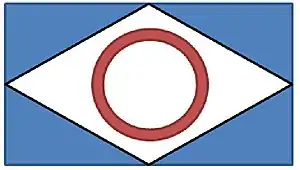 | |
| Industry | Shipping, transportation |
|---|---|
| Predecessor | Societe d'Etudes de navigation |
| Successor | Chargeurs Réunis |
| Founded | 1912 |
| Founder | Cyprien Fabre |
| Defunct | 1962 |
Area served | South America |
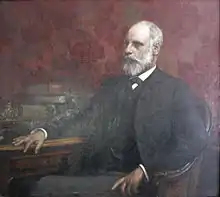
Founding
In July 1912 a new convention was entered into between the French government and the Societe d'Etudes de navigation, a nominal concessionaire, which ceded its rights to the Compagnie de Navigation Sud-Atlantique. Messageries Maritimes, had held the contracts for the South American routes since 1860, but had done very little since 1904 to improve their South American service regarding it as not particularly profitable, though the speed of Messageries ships was also an issue. [1]
The contract, signed on 11 July 1911,[2] was for 25 years beginning 22nd of July 1912 and provided for a subsidised postal service, with round=trip voyages every two weeks between Bordeaux, Lisbon, Dakar, Rio de Janeiro, Montevideo and Buenos Aires.[3]
In addition the company was required to operate a non-subsidised commercial service with voyages at least once per month between Bordeaux, Dakar, Pernambuco, Bahia, Rio de Janeiro, Santos, Montevideo and Buenos Aires by vessels of not less than 4,000 tons cargo capacity and not less than 11 knots average speed.
The Compagnie de Navigation Sud-Atlantique was launched in early 1912 , its capital being 15 million francs (£600,000).
Fleet
As a precondition (art.26) for the subsidised contract and to ensure that sufficient ships were in service to provide a reliable mail service, the company was required to build, in France, four passenger liners of a minimum displacement of 11,000 tonnes, able to maintain a minimum speed of 15 knots between Bordeaux and Lisbon, and 18 knots between Lisbon and Buenos Aires. with a minimum length of 175 metres and provide six paquebots mixtes (passenger freighters). [3]
The new company placed orders for new ships, with the Chantiers de l'Atlantique at St. Nazaire for the SS Lutetia (14,000 tons) and with Forges & Chantiers de la Mediterranee at La Seyne for a similar ship, the SS Gallia,[4] both to be delivered in 1913. The third ship was the SS Massilia, also built at La Seyne and launched in 1914, but not completed until 1920.[5] The Gallia was able to make the passage from Bordeaux to Buenos Aires in 15 days.
To achieve the promised service levels, (while the new-builds were advancing) the agreement (art.97) allowed that, temporarily, the company might operate vessels of 9,000 tons displacement at a speed of 14 knots from Buenos Aires to Lisbon and 15 knots from Lisbon to Buenos Aires and two of the vessels might be of foreign construction.[3]
Thus a number of second-hand ships had to be acquired in order inaugurate the service. These included the "Avondale Castle" launched in 1897 (from the Union-Castle Line) and the quite aged La Bretagne and La Gascogne, which had been built as far back as 1886. These latter two were transferred from the Compagnie Générale Transatlantique. The long-moribund (and extremely troublesome) Kaiser Friedrich was added to the fleet, and renamed the Burdigala) but swiftly proved less useful than hoped.
Early on the in the new company's existence a decision was made to paint the line's vessels in white. Therefore in the second half of the year 1913 all vessels were painted in this way.
The company also had the practice of giving its ships the Latin variations of French names. For example, Lutetia=Paris, Massilia=Marseille, Gallia=Gaul, Burdigala=Bordeaux.
Due to the conditions created in the First World War, the 1912 was revised and renewed for a period of 10 years from the 13th of August 1920. [3]
The Gallia was lost in the First World War (with substantial loss of life) while serving as a troopship. The Burdigala was also lost on troopship duties in Greek waters. The required fourth ship of series was never built. The Massilia joined the Lutetia as "running mates" in the post-war period. The next major addition was the iconic L'Atlantique (with nearly 41,000 tonnes) in 1930 but its working life proved to be short, being destroyed by fire while sailing from Bordeaux to Le Havre in 1933. This necessitated the scrapping of the vessel. In 1939 the Pasteur (at 29,000 tonnes – reflecting lowered demand on the route) was added to the fleet.
The Massilia might be called "the ship of exile" in its latter days. In 1939, on its voyage from La Rochelle, leaving 19 October 1939 arriving Buenos Aires the 5th of November 1939, the ship was painted camouflage grey to dodge German submarines which were already on the prowl. It carried on board 384 passengers fleeing Europe, of which the largest contingent were Spanish republicans who had previously taken refuge in France. Amongst this group were many artists, journalists, writers, academics and theatre figures. [6]
It also played a starring role in June 1940, carrying a large number of prominent politicians, including 27 of the Vichy 80, fleeing France to North Africa after the surrender of the country to the Nazi invaders and the assumption of the Vichy government.[7]
The company was said to have ships that were ill-fated,[5] undoubtedly true for the Gallia, L'Atlantique and Burdigala, but clearly not true for the long-service lives of the Lutetia, Pasteur and Massilia.
Change of Control
In 1914, the company was placed under the control of the Compagnie Générale Transatlantique and was taken over in 1916 by Chargeurs Réunis. In 1928 Chargeurs Réunis took over Sud Atlantique's intermediate service.
Messageries Maritimes took over the South American service in 1962,[1] with the only two ships still left (Laennec and Charles Tellier). This ended the Compagnie de Navigation Sud-Atlantique as a brand name.
Ships of the Compagnie de Navigation Sud-Atlantique
| Name | Shipyard | GRT | Length [m] | Passengers | Launched | Notes |
|---|---|---|---|---|---|---|
| Alba | Bremer Vulkan, Bremen | 8324 | 125.3 | – | 1912 | ex-Sierra Ventana built for Norddeutscher Lloyd, 1919 seized by France, 1920 purchased from French Government renamed Alba, 1926 sold to Chargeurs Reunis renamed Amerique, 1936 scrapped. |
| Burdigala | F. Schichau, Danzig | 12480 | 183 | 400 First Class, 250 Second Class, 700 Third Class | 1898 | ex-Kaiser Friedrich, 1912 purchased from Norddeutscher Lloyd renamed Burdigala, 1913 laid up, 1917 mined and sunk in the Kea Channel, near Mykonos.[8] |
| Charles Tellier | Ateliers & Chantiers de La Loire, St. Nazaire | 12007 | 125.3 | – | 1952 | 1962 transferred to Messageries Maritimes not renamed, 1967 sold to Hong Kong owners (Panama flag) renamed Le Havre Abeto, 1978 laid up, 1984 scrapped. |
| Divona | Fairfield Shipbuilding Co., Glasgow | 6405 | 125.3 | – | 1887 | ex-Ormuz, 1912 purchased from Orient Steam Nav. Co. renamed Divona, 1919 laid up, 1922/23 scrapped. |
| Gallia | Forges & Chantiers de la Mediterranee, La Seyne | 14966 | 174.7 | – | 1913 | 1914 armed merchant cruiser later troopship, 1916 torpedoed and sunk as a troopship by German submarine U-35 with the loss of 600+ lives. |
| Garonna | Fairfield Shipbuilding Co., Glasgow | 5531 | 125.3 | – | 1897 | ex-Avondale Castle, 1912 purchased from Union Castle Line renamed Garonna, 1920 scrapped |
| La Bretagne | Chantiers de Penhoet, St. Nazaire | 7112 | 150 | 390 first class, 65 second class, 600 third class | 1886 | ex-La Bretagne, 1912 transferred from Cie. Generale Transatlantique not renamed, 1919 renamed Alesia, 1923 sold for scrapping, whilst under tow, the towline parted and the vessel ended up stranded on the Dutch island of Texel |
| La Gascogne | Forges & Chantiers de la Mediterranee, La Seyne | 7395 | 125.3 | – | 1886 | ex-La Gascogne launched as L'Algerie, 1912 transferred from Cie. Generale Transatlantique not renamed, 1918 reverted to CGT, 1919 scrapped. |
| Laennec | Ateliers & Chantiers de La Loire, St. Nazaire | 12007 | 125.3 | – | 1952 | 1962 transferred to Messageries Maritimes not renamed, 1966 sold to Hong Kong owners (Panama flag) renamed Belle Abeto, 1976 destroyed by fire. |
| L'Atlantique | Chantiers de l'Atlantique, St. Nazaire | 40945 | 223 | 1238 | 1930 | 1933 damaged by fire, 1936 scrapped at Port Glasgow. |
| SS Lutetia | Chantiers de l'Atlantique, St. Nazaire | 14783 | 175 | 958 | 1913 | 1914 troopship for US forces in the Transport Force Newport News Division, 1915 armed merchant cruiser, later hospital ship and again troopship, 1919/20 refitted and in 1920 returned to service, 1938 laid up and scrapped. |
| Massilia | Forges & Chantiers de la Mediterranee, La Seyne | 15147 | 175 | 1000 | 1930 | Construction delayed by WW1. Completed in 1920, 1940 laid up at Marseilles and used as a naval-training school, 1944 scuttled by Germans to block the port of Marseilles, wreck later scrapped. |
| Mosella | Swan, Hunter & Wigham Richardson, Wallsend on Tyne | 10123 | 147 | – | 1922 | 1927 participated in rescue of the passengers of the SS Principessa Mafalda, 1928 to Chargeurs Reunis renamed Jamaique, 1954 scrapped. |
| Pasteur | Chantiers de l'Atlantique, St. Nazaire | 29253 | 212.4 | 751 | 1938 | 1940 placed under Cunard-White Star Management, 1945 returned to owners, 1957 laid up, 1957 sold to Norddeutscher Lloyd renamed Bremen, 1971 sold to Chandris Line, renamed Regina Magna, 1974 laid up, 1977 floating hotel at Djeddah renamed Saudiphil 1, 1980 renamed Filipinas Saudi 1, 1980 sunk in tow to the breakers. |
| Sequana | Workman Clark & Co. Ltd. Belfast Northern Ireland | 5557 | 138 | 566 | 1898 | Built for the Ellerman Lines as the City of Corinth and sold in 1912 to the Cie de Navigantion Sud-Atlantique. Torpedoed on 8th June 1917 by German U-boot UC-72 in the Bay of Biscay. Some 196 (mostly Senegalese) troops, three passengers and six crew lost their lives. |
The Fleet
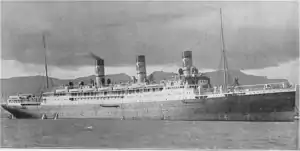 SS Gallia shortly after launch in 1913
SS Gallia shortly after launch in 1913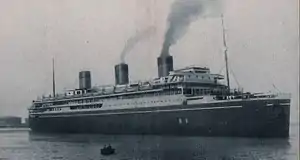 L'Atlantique 1930-1933
L'Atlantique 1930-1933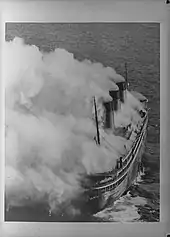 SS L'Atlantique on fire (January 1933)
SS L'Atlantique on fire (January 1933)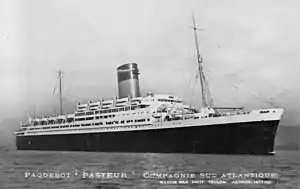 SS Pasteur
SS Pasteur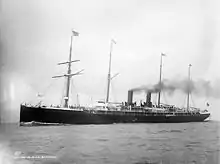 La Bretagne as she appeared c. 1890–1895
La Bretagne as she appeared c. 1890–1895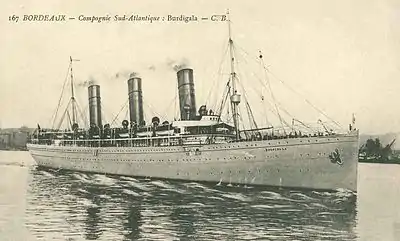 SS Burdigala
SS Burdigala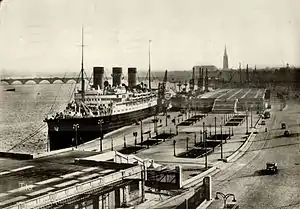 SS Massilia at Bordeaux
SS Massilia at Bordeaux
References
- "L'ENCYCLOPEDIE DES MESSAGERIES MARITIMES:HISTOIRE RAPIDE DE LA COMPAGNIE". Retrieved 22 June 2020.
- Berneron-Couvenhes, Marie-Françoise (2007). Les messageries maritimes: l'essor d'une grande compagnie de navigation française, 1851–1894. Presses Paris Sorbonne.
-
US Department of Commerce (1932). Trade Promotion Series, Issue 129. U.S. Government Printing Office. p. 110. Retrieved 22 June 2020.

- Hillion, Daniel (1992). Paquebots. éd. Ouest-France.
- "Massilia, paquebot de la Compagnie de navigation Sud-Atlantique". Retrieved 25 June 2011.
- Ortuño Martínez, Bárbara. ""En busca de un submarino". Crónica a bordo del buque insignia del exilio republicano en Argentina: el Massilia "". Cahiers de civilisation espagnole contemporaine. Retrieved 23 June 2020.
- Planes, Louis-Georges; Dufourg, Robert. Bordeaux, Capitale tragique, mai-juin 1940. Editions Medicis, Loos.
- "The sad story of SS Burdigala". keadive.gr. 7 November 2009. Retrieved 14 November 2015.